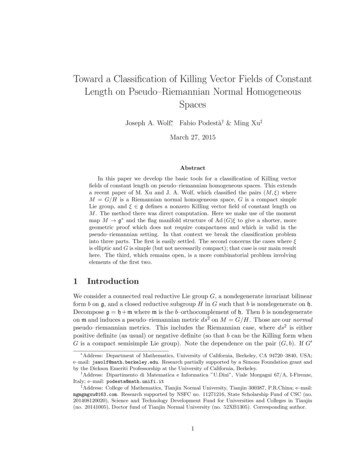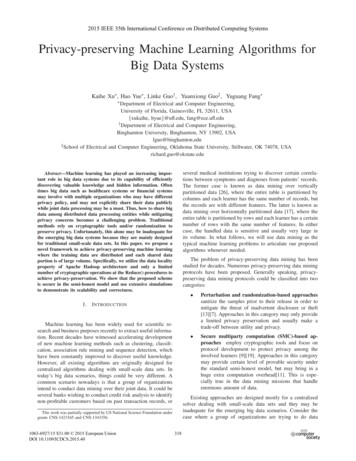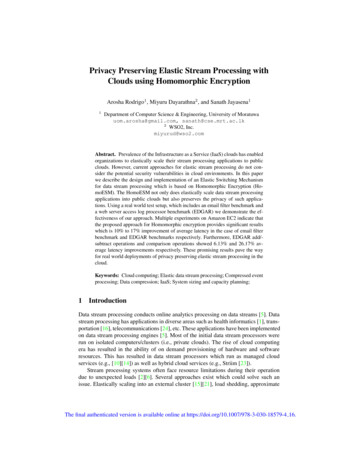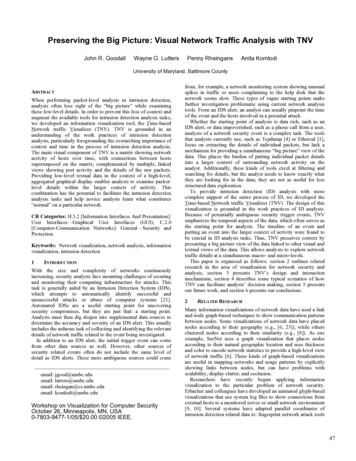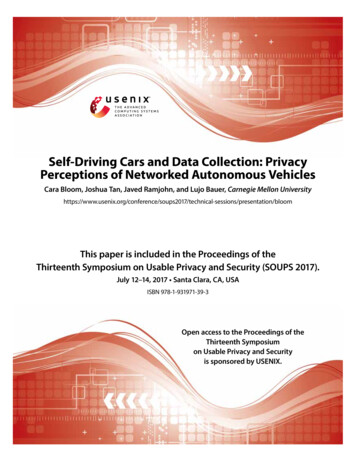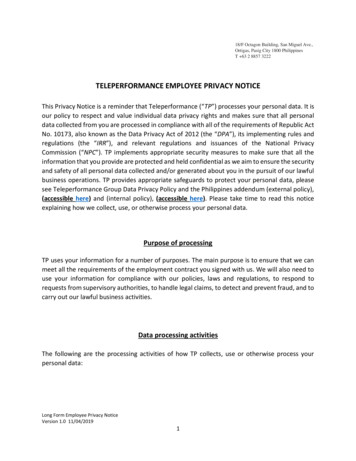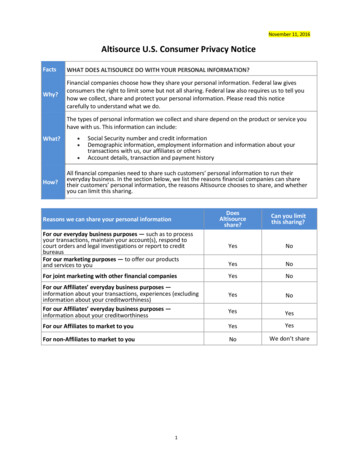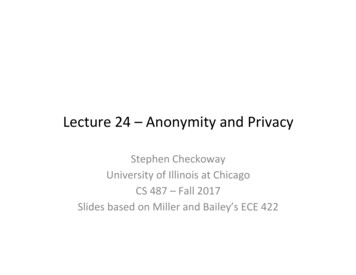
Transcription
1Privacy-Preserving Classification of Personal TextMessages with Secure Multi-Party Computation:An Application to Hate-Speech DetectionDevin Reich, Ariel Todoki, Rafael Dowsley, Martine De Cock, Anderson C. A. Nascimentotexts; the only existing method is based on HomomorphicEncryption (HE) and takes 19 minutes to classify a tweet [17]while leaking information about the text being classified. Inour SMC based solution, there are two parties, nick-namedAlice and Bob (see Fig. 1). Bob has a trained ML model thatcan automatically classify texts. Our secure text classificationprotocol allows to classify a personal text written by Alicewith Bob’s ML model in such a way that Bob does not learnanything about Alice’s text and Alice does not learn anythingabout Bob’s model. Our solution relies on PP protocols forfeature extraction from text and PP machine learning modelscoring, which we propose in this paper.We perform end-to-end experiments with an application forPP detection of hate speech against women and immigrantsIndex Terms—Text classification, privacy-preserving, secure in text messages. In this use case, Bob has a trained logisticmultiparty computation.regression (LR) or AdaBoost model that flags hateful textsbased on the occurrence of particular words. LR models onwordn-grams have been observed to perform comparably toI. I NTRODUCTIONmorecomplex CNN and LSTM model architectures for hateThe ability to elicit information through automated scanningspeechdetection [37]. Using our protocols, Bob can labelof personal texts has significant economic and societal value.Alice’stextsas hateful or not without learning which wordsMachine learning (ML) models for classification of text suchoccurinAlice’stexts, and Alice does not learn which wordsas e-mails and SMS messages can be used to infer whetherareinBob’shatespeech lexicon, nor how these words arethe author is depressed [48], suicidal [44], a terrorist threatusedintheclassificationprocess. Moreover, classification is[2], or whether the e-mail is a spam message [3], [52]. Otherdoneinseconds,whichistwo orders of magnitude better thanvaluable applications of text message classification include usertheexistingHEsolutiondespitethe fact we use over 20 timesprofiling for tailored advertising [34], detection of hate speechmorefeaturesanddonotleakanyinformation about Alice’s[7], and detection of cyberbullying [54]. Some of the above aretexttothemodelowner(Bob).Thesolutionbased on HE leaksintegrated in parental control applications1 that monitor textwhichwordsinthetextarepresentinBob’slexicon [17].messages on the phones of children and alert their parents hinecontent related to drug use, sexting, suicide etc. is dbyRegardless of the clear benefits, giving applications access hinone’s personal text messages and e-mails can easily lead tothemselves or with new protocols added to the framework.(un)intentional privacy violations.In this paper, we propose the first privacy-preserving (PP) On top of existing building blocks, we also propose a novelsolution for text classification that is provably secure. To the protocol for binary classification over binary input featuresbest of our knowledge, there are no existing Differential Privacy with an ensemble of decisions stumps. While some of our(DP) or Secure Multiparty Computation (SMC) based solutions building blocks have been previously proposed, the mainfor PP feature extraction and classification of unstructured contribution of this work consists of the careful choice ofthe ML techniques, feature engineering and algorithmic andDevin Reich, Ariel Todoki, Martine De Cock, Anderson C. A. Nasci- implementation optimizations to enable end-to-end practical PPmento are with the School of Engineering and Technology, Unitext classification . Additionally, we provide security definitionsversity of Washington Tacoma, Tacoma, WA 98402. Emails: {dreand proofs for our proposed l Dowsley is with the Faculty of Information Technology, MonashA conference version of this work appeared at NeurIPS 2019University, Melbourne, Australia. Email: rafael.dowsley@monash.edu[49].This full version contains the security analysis as wellMartine De Cock is a Guest Professor at Dept. of Applied Mathematics,Abstract—Classification of personal text messages has manyuseful applications in surveillance, e-commerce, and mentalhealth care, to name a few. Giving applications access to personaltexts can easily lead to (un)intentional privacy violations. Wepropose the first privacy-preserving solution for text classificationthat is provably secure. Our method, which is based on SecureMultiparty Computation (SMC), encompasses both feature extraction from texts, and subsequent classification with logistic regression and tree ensembles. We prove that when using our securetext classification method, the application does not learn anythingabout the text, and the author of the text does not learn anythingabout the text classification model used by the application beyondwhat is given by the classification result itself. We perform endto-end experiments with an application for detecting hate speechagainst women and immigrants, demonstrating excellent runtimeresults without loss of accuracy.Computer Science, and Statistics, Ghent University1 https://www.bark.us/, https://kidbridge.com/, https://www.webwatcher.com/2 https://bitbucket.org/uwtppml
2as a new more efficient implementation in Rust.II. R ELATED WORKThe interest in privacy-preserving machine learning (PPML)has grown substantially over the last decade. The best-knownresults in PPML are based on differential privacy (DP), atechnique that relies on adding noise to answers, to preventan adversary from learning information about any particularindividual in the dataset from revealed aggregate statistics [32]. Fig. 1. Roles of Alice and Bob in SMC based text classificationWhile DP in an ML setting aims at protecting the privacy ofindividuals in the training dataset, our focus is on protecting theapplication of our equality test protocol. While more efficientprivacy of new user data that is classified with proprietary MLprotocols could be obtained by using sophisticated hashingmodels. To this end, we use Secure Multiparty Computationtechniques, we have decided to stick with our direct solution(SMC) [18], a technique in cryptography that has successfullysince it has no probability of failure and works well for thebeen applied to various ML tasks with structured data (seeinput sizes needed in our problem. For larger input sizes, ae.g. [15], [21], [23], [42] and references therein).more sophisticated protocol would be a better choice [47].To the best of our knowledge there are no existing DP orWe use two protocols for the secure classification of featureSMC based solutions for PP feature extraction and classificationvectors: an existing protocol πLR for secure classification withof unstructured texts. Defenses against authorship attributionLR models [21]; and a novel secure AdaBoost classificationattacks that fulfill DP in text classification have been proposedprotocol. The logistic regression protocol uses solely additions[56]. These methods rely on distortion of term frequencyand multiplications over a finite field. The secure AdaBoostvectors and result in loss of accuracy. In this paper we addressclassification protocol is an novel optimized protocol that usesa different challenge: we assume that Bob knows Alice, so nosolely decision trees of depth one, binary features and a binaryauthorship obfuscation is needed. Instead, we want to processoutput. All these characteristics were used in order to speed upAlice’s text with Bob’s classifier, without Bob learning whatthe resulting protocol. The final secure AdaBoost classificationAlice wrote, and without accuracy loss. To the best of ourprotocol uses only two secure inner products and one secureknowledge, Costantino et al. [17] were the first to propose PPcomparison.feature extraction from text. In their solution, which is basedGeneric protocols for private scoring of machine learningon homomorphic encryption (HE), Bob learns which of hismodels have been proposed in [9]. The solutions proposedlexicon’s words are present in Alice’s tweets, and classificationin [9] cannot be used in our setting since they assume thatof a single tweet with a model with less than 20 features takesthe features’ description are publicly known, and thus can be19 minutes. Our solution does not leak any information aboutcomputed locally by Alice and Bob. However, in our case, theAlice’s words to Bob, and classification is done in seconds,features themselves are part of the model and cannot be madeeven for a model with 500 features.public.Below we present existing work that is related to some ofFinally, we note that while we implemented our protocolsthe building blocks we use in our PP text classification protocolusing our own framework for privacy-preserving machine(see Section IV-A).learning3 , any other generic framework for SMC could bePrivate equality tests have been proposed in the literaturealso used in principle [50], [24], [43].based on several different flavors [4]. They can be based on YaoGates, Homomorphic Encryption, and generic SMC [55]. InIII. P RELIMINARIESour case, we have chosen a simple protocol that depends solelyon additions and multiplications over a binary field. WhileWe consider honest-but-curious adversaries, as is common indifferent (and possibly more efficient) comparison protocols SMC based PPML (see e.g. [21], [23]). An honest-but-curiouscould be used instead, they would either require additional adversary follows the instructions of the protocol, but triescomputational assumptions or present a marginal improvement to gather additional information. Secure protocols prevent thein performance for the parameters used here.latter.Our private feature extraction can be seen as a particular caseWe perform SMC using additively secret shares to doof private set intersection (PSI). PSI is the problem of securely computations modulo an integer q. A value x is secret sharedcomputing the intersection of two sets without leaking any over Zq {0, 1, . . . , q 1} between parties Alice and Bobinformation except (possibly) the result, such as identifying the by having xA , xB Zq that are uniformly random subject tointersection of the set of words in a user’s text message with the the constraint that x xA xB mod q, and then revealinghate speech lexicon used by the classifier. Several paradigms xA to Alice and xB to Bob. We denote this secret sharing byhave been proposed to realize PSI functionality, including a [[x]]q , which can be thought of as a shorthand for (xA , xB ).Naive hashing solution, Server-aided PSI, and PSI based on Secret-sharing based SMC works by first having the partiesoblivious transfer extension. For a complete survey, we refer split their respective inputs in secret shares and send some ofto Pinkas et al. [47]. In our protocol for PP text classification,3 https://bitbucket.org/uwtppmlwe implement private feature extraction by a straightforward
3these shares to each other. Naturally, these inputs have to be to him.mapped appropriately to Zq . Next, Alice and Bob represent thefunction they want to compute securely as a circuit consisting ofIV. S ECURE TEXT CLASSIFICATIONaddition and multiplication gates. Alice and Bob will performsecure additions and multiplications, gate by gate, over theOur general protocol for PP text classification relies onshares until the desired outcome is obtained. The final result several building blocks that are used together to accomplishcan be recovered by combining the final shares, and disclosed Step 1 in Fig. 1: a secure equality test, a secure comparisonas intended, i.e. to one of the parties or to both. It is also test, private feature extraction, secure protocols for convertingpossible to keep the final result distributed over shares.between secret sharing modulo 2 and modulo q 2, andIn SMC based text classification, as illustrated in Fig. 1, private classification protocols. Several of these building blocksAlice’s input is a personal text x and Bob’s input is an ML have been proposed in the past. However, to the best of ourmodel M for text classification. The function that they want knowledge, this is the very first time they are combined in orderto compute securely is f (x, M) M(x), i.e. the class label to achieve efficient text classification with provable security.of x when classified by M. To this end, Alice splits the text inWe assume that Alice has a personal text message, andsecret shares while Bob splits the ML model in secret shares. that Bob has a LR or AdaBoost classifier that is trained onBoth parties engage in a protocol in which they send some unigrams and bigrams as features. Alice constructs the setof the input shares to each other, do local computations on A {a , a , . . . , a } of unigrams and bigrams occurring in1 2mthe shares, and repeat this process in an iterative fashion over her message, and Bob constructs the set B {b , b , . . . , b }1 2nshares of intermediate results (Step 1). At the end of the joint of unigrams and bigrams that occur as features in his MLcomputations, Alice sends her share of the computed class label model. We assume that all a and b are in the form of bitjito Bob (Step 2), who combines it with his share to learn the strings. To achieve this, Alice and Bob convert each unigramclassification result (Step 3). As mentioned above, the protocol and bigram on their end to a number N using SHA 224 [46],for Step 1 involves representing the function f as a circuit of strictly for its ability to map the same inputs to the sameaddition and multiplication gates.outputs in a pseudo-random manner. Next Alice and Bob mapGiven two secret sharings [[x]]q and [[y]]q , Alice and Bob each N on their end to a number between 0 and 2l 1, i.e. acan locally compute in a straightforward way a secret sharing bit string of length l, using a random function in the universal[[z]]q corresponding to z x y or z x y by simply hash family proposed by Carter and Wegman [13].4 In theadding/subtracting their local shares of x and y modulo q. remainder we use the term “word” to refer to a unigram orGiven a constant c, they can also easily locally compute a bigram, and we refer to the set B {b , b , . . . , b } as Bob’s1 2nsecret sharing [[z]]q corresponding to z cx or z x c: in lexicon.the former case Alice and Bob just multiply their local sharesBelow we outline the protocols for PP text classification. Aof x by c; in the latter case Alice adds c to her share of x correctness and security analysis of the protocols is providedwhile Bob keeps his original share. These local operations in the next section. In the description of the protocols in thiswill be denoted by [[z]]q [[x]]q [[y]]q , [[z]]q [[x]]q [[y]]q , paper, we assume that Bob needs to learn the result of the[[z]]q c[[x]]q and [[z]]q [[x]]q c, respectively. To allow for classification, i.e. the class label, at the end of the computations.very efficient secure multiplication of values via operations on It is important to note that the protocols described below cantheir secret shares (denoted by [[z]]q [[x]]q [[y]]q ), we use a be straightforwardly adjusted to a scenario where Alice insteadtrusted initializer that pre-distributes correlated randomness to of Bob has to learn the class label, or even to a scenario wherethe parties participating in the protocol before the start of Step neither Alice nor Bob should learn what the class label is and1 in Fig. 1. The initializer is not involved in any other part of instead it should be revealed to a third party or kept in a secretthe execution and does not learn any data from the parties. This sharing form. All these scenarios might be relevant use casescan be straightforwardly extended to efficiently perform secure of PP text classification, depending on the specific applicationmultiplication of secret shared matrices. The protocol for secure at hand.multiplication of secret shared matrices is denoted by πDMMand for the special case of inner-product computation by πIP .Details about the (matrix) multiplication protocol can be found A. Cryptographic building blocksin [21]. We note that if a trusted initializer is not availablea) Secure Equality Test: At the start of the secure equalityor desired, Alice and Bob can engage in pre-computations totestprotocol,Alice and Bob have secret shares of two bit stringssecurely emulate the role of the trusted initializer, at the costx x.xand y y . . . y1 of length . x corresponds to a 1of introducing computational assumptions in the protocol [21].wordfromAlice’smessage and y corresponds to a feature fromThe trusted initializer additionally generates random valuesBob’smodel.Thebit strings x and y are secret shared overin Zq and delivers them to Alice so that she can use themZ.AliceandBobfollow the protocol to determine whether2to secret share her inputs. If Alice wants to secret share anx y.TheprotocolπEQ outputs a secret sharing of 1 if x yinput x, she picks an unused random value r (note that Bobandof0otherwise.does not know r), and sends c x r to Bob. Her share xAof x is then set to xA r, while Bob’s share xB is set to4 The hash function is defined as ((a · N b) mod p) mod 2l 1 wherexB c. The secret sharing of Bob’s inputs is done similarly p is a prime and a and b are random numbers less than p. In our experiments,using random values that the trusted initializer only delivers p 1, 301, 081, a 972, and b 52, 097.
4Protocol πEQrestricted ourselves to the original protocol without hashingand without any probability of failure. For i 1, . . . , , Alice and Bob locally computec) Secure Comparison Test: In our privacy-preserving[[ri ]]2 [[xi ]]2 [[yi ]]2 1.AdaBoost classifier we will use a secure comparison protocol Alice and Bob use secure multiplication to computeas a building block. At the start of the secure comparison testa secret sharing of z r1 · r2 · . . . · r . If x y, thenprotocol, Alice and Bob have secret shares over Z2 of twori 1 for all bit positions i, hence z 1; otherwisebit strings x x . . . x1 and y y . . . y1 of length . Theysome ri 0 and therefore z 0. The result is therun the secure comparison protocol πDC of Garay et al. [36]secret sharing [[z]]2 , which is the desired output ofwith secret sharings over Z2 and obtain a secret sharing of 1the protocol.if x y and of 0 otherwise.d) Secure Conversion between Zq and Z2 : Some of ourThis protocol for equality test is folklore in the field of SMC. building blocks perform computations using secret shares overThe 1 multiplications can be organized in as binary tree Z2 (secure equality test, comparison and feature extraction),with the result of the multiplication at the root of the tree. while the secure inner product works over Zq for q 2. InIn this way, the presented protocol has log( ) rounds. While order to be able to integrate these building blocks we need:there are equality test protocols that have a constant number of (1) A secure bit-decomposition protocol for secure conversionrounds, the constant is prohibitively large for the parameters from Zq to Z2 . Alice and Bob have as input a secret sharing[[x]]q and without learning any information about x they shouldused in our implementation.b) Secure Feature Vector Extraction: At the start of obtain as output secret sharings [[xi ]]2 , where x · · · x1 is thethe feature extraction protocol πFE , Alice has a set A binary representation of x. We use the secure bit-decomposition{a1 , a2 , . . . , am } and Bob has a set B {b1 , b2 , . . . , bn }. A protocol πdecomp from De
text classification method, the application does not learn anything about the text, and the author of the text does not learn anything . secure additions and multiplications, gate by gate, over the shares until
